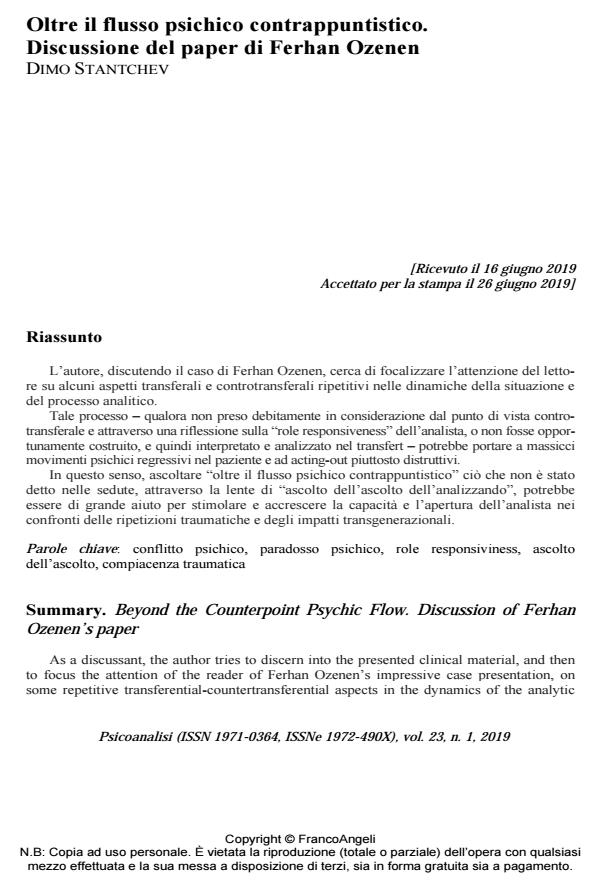Beyond the Counterpoint Psychic Flow. Discussion of Ferhan Ozenen’s paper
Journal title PSICOANALISI
Author/s Dimo Stantchev
Publishing Year 2019 Issue 2019/1 Language Italian
Pages 7 P. 77-83 File size 144 KB
DOI 10.3280/PSI2019-001008
DOI is like a bar code for intellectual property: to have more infomation
click here
Below, you can see the article first page
If you want to buy this article in PDF format, you can do it, following the instructions to buy download credits

FrancoAngeli is member of Publishers International Linking Association, Inc (PILA), a not-for-profit association which run the CrossRef service enabling links to and from online scholarly content.
As a discussant, the author tries to discern into the presented clinical material, and then to focus the attention of the reader of Ferhan Ozenen’s impressive case presentation, on some repetitive transferential-countertransferential aspects in the dynamics of the analytic situation and process, which, if not being duly taken into account in the countertransference and through the reflection on the "role responsiveness" of the analyst, or not being opportunely pointed-out, constructed, and then interpreted and analysed in the transference, could lead to some massive regressive psychic movements in the patient and to a rather destructive acting-outs. In this sense, listening "beyond the contrapuntal psychic flow" to what has not been said in the sessions, through the lens of "listening of the analysand’s listening", could be of great help for stimulating and enhancing the analyst’s capacity and openness towards traumatic repetitions and transgenerational impacts.
Keywords: Psychic conflict, psychic paradox, role responsiveness, listening to listening, traumatic compliance
- Abraham N., Torok M. (1987). L’écorce et le noyau. Paris: Flammarion.
- Faimberg H. (2005). The telescoping of generations: listening to the narcissistic links between generations. New York: Routledge.
- Freud S. (1950). Project for a Scientific Psychology (1950 [1895]). In: SE, 1.
- Freud S. (1927). Fetishism. In: SE, 21.
- Freud S. (1938). Splitting of the Ego in the Process of Defence. In: SE, 23.
- Green A. (2000). The Central Phobic Position: A new Formulation of The Free Association Method. Int. J. Psycho-Anal., 81, 3: 429-451.
- Joseph B. (1983). On Understanding and not Understanding: Some Technical Issues. Int. J. Psycho-Anal., 64: 291-298
- Joseph B. (1988). The patient who is difficult to reach. In: Bott Spillius E. (ed.), Melanie Klein Today. Mainly Practice. London: Routledge, vol. 2, pp. 48-60.
- Killingmo B. (1989). Conflict and Deficit: Implications for Technique. Int. J. Psycho-Anal., 70: 65-79.
- Klein M. (1975). Envy and Gratitude and Other Works (1946-1963). In: Masud M., Khan R. (eds.), The International Psycho-Analytical Library, 104: 1-36. London: The Hogarth Press and the Institute of Psycho-Analysis.
- Sandler J (1976). Countertransference and Role-Responsiveness. Int. R. Psycho_Anal., 3: 43-47.
Dimo Stantchev, Oltre il flusso psichico contrappuntistico. Discussione del paper di Ferhan Ozenen in "PSICOANALISI" 1/2019, pp 77-83, DOI: 10.3280/PSI2019-001008